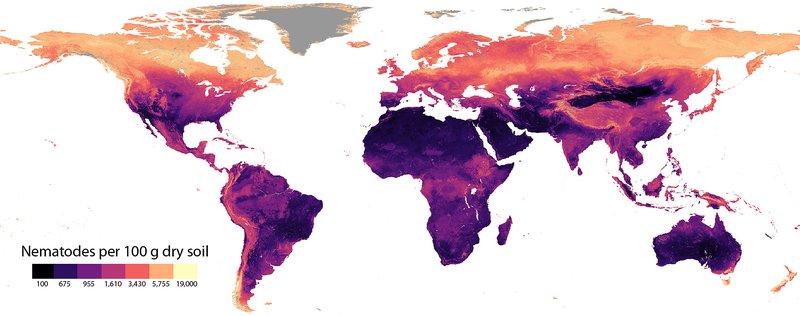
These creatures have a unique life cycle that involves some rather shocking transformations. They begin as larvae, often within a host like an insect, and later emerge to live freely in water. Their *documented range and distribution worldwide* reflects not just their adaptability but also the delicate ecosystems they inhabit. Let’s explore where these peculiar worms are found and what that means for our understanding of biodiversity.
What Are Nematomorphs?
Nematomorphs belong to a phylum called Nematomorpha. But don’t let that fancy term scare you off. In simple terms, they’re parasitic worms that have a life cycle intertwined with various insects. They’re typically long and slender, resembling strands of hair or spaghetti, hence the nickname “horsehair worms.”
These fascinating creatures can grow quite long—up to several feet in some species! While they’re not particularly harmful to humans, they can be quite dramatic in their life cycles. Think of them as nature’s version of a superhero, transforming from simple larvae to free-roaming adults. They’re the ultimate survivors, often found in freshwater habitats like streams, ponds, and marshes.
Global Distribution of Nematomorphs
Nematomorphs are found almost *everywhere*—from tropical rainforests to temperate regions, and even in colder climates. Their ability to thrive in various environments showcases their adaptability. They prefer moist habitats, which is why you’ll often find them in wet soil or in water bodies.
In North America, for example, several species have been identified. The eastern United States boasts a diverse range of nematomorphs, including species like *Horsehair worm*, which can be found in *California* and along the eastern seaboard. This variety is just one part of a much larger picture that spans the globe.
Climate Influence on Distribution
Climate plays a crucial role in the distribution of nematomorphs. In regions with extreme temperatures or significant seasonal shifts, these worms rely heavily on specific environmental conditions to survive. For instance, nematomorphs tend to flourish in humid conditions where they can easily find their hosts and reproduce.
Rainy seasons often see a spike in nematomorph activity. When it rains, they emerge from their hosts, which can include insects like grasshoppers or crickets. If you’ve ever seen a grasshopper jumping wildly before a rainstorm, it’s likely been affected by these worms. That’s the magic of their parasitic life cycle—once they’re ready to reproduce, they steer their host toward water, ensuring their offspring have a suitable environment.
Habitat Variety and Ecosystem Impact
Nematomorphs can inhabit various ecosystems, but they’re most commonly found in freshwater environments. Here’s where it gets interesting: they play a vital role in those ecosystems. By controlling insect populations, they help maintain balance.
Imagine a pond where insects are out of control. Enter the nematomorphs, which can reduce those populations by parasitizing their hosts. This pivotal role in the food web shows how interconnected life can be. It’s a delicate dance where every species, including nematomorphs, contributes to the overall health of their environment.
Notable Species and Their Ranges
While many species of nematomorphs exist, a few notable ones stand out due to their unique features and compelling ranges. For instance, *Dicrocoelium dendriticum*, often referred to as the lancet liver fluke, is one such species that demonstrates the complexities of parasitism. While it primarily affects sheep and cows, it also has an intricate relationship with snails and ants, showcasing the tangled web of life.
Conversely, *Nectonema puertoricensis* is another interesting species found in the Caribbean and can even thrive in brackish waters. The ability of different nematomorphs to occupy distinct habitats highlights their adaptability and resilience in the face of environmental changes.
Conservation Concerns for Nematomorphs
Although nematomorphs are widespread, they’re not immune to the same threats facing many species today. Habitat destruction, climate change, and pollution can significantly impact their populations. As wetlands and freshwater ecosystems are compromised, the delicate balance they help maintain can falter.
Conservation efforts focused on protecting natural habitats are essential for the survival of nematomorphs. The loss of biodiversity can lead to unexpected consequences, including the collapse of the ecosystems they support. Preserving these creatures means acknowledging their role in our environment and taking steps to protect it.
From their astonishing life cycles to their crucial roles in ecosystems, nematomorphs are truly a hidden gem in the animal kingdom. Their documented range and distribution worldwide offer us valuable insights into the health of various environments. As we learn more about these unique creatures, we can better appreciate the delicate balance of our ecosystems.
So, next time you come across a strange-looking worm or see a grasshopper behaving oddly, remember the story of the nematomorphs. They might just be doing what they do best—keeping nature in check while reminding us of the fascinating complexities of life on Earth. Embrace the wonders of nematomorphs; they’re a reminder that even the smallest creatures can have a significant impact.
